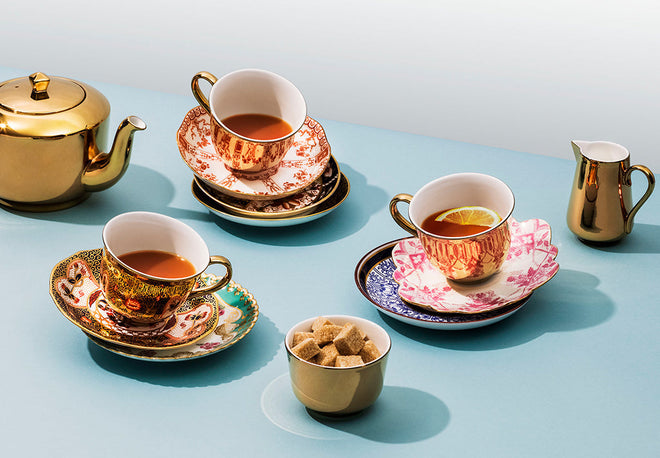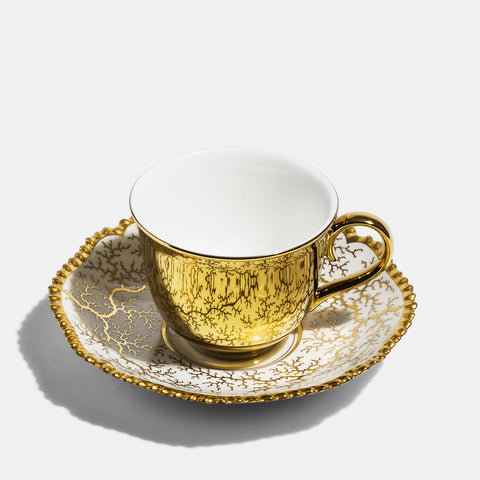
19/11/21
REFLECTING THE PAST: REINTRODUCING THE REFLECT COLLECTION
With the return of our signature Reflect collection, we’re reflecting on the past, both our own and that of the gloriously rich history of British pottery. Following the collection's original launch in 2013, we're now taking a deep dive into the surprisingly dramatic history of British ceramics.
The collection started with Richard’s many wanderings down Portobello Road, the home of one of the world's most famous and well-loved antique markets. As the antique market opens, the streets become littered with oddities and curiosities... antique saucers are a regular sight. Less common are their matching teacups, their more strenuous use causing many to be lost over the centuries. Feeling that these orphaned saucers needed a new lease of life, the Reflect collection was born.

With the mirrored surface of our gold and platinum teacups, each antique saucer is brought back to life. The reflection of the rich gilt detailing and intricate hand-painted patterns of floral, oriental and pastoral designs brings the saucers back to life as they delicately weave up the bowl of the cup. By bringing a purpose back to these discarded relics of a rich heritage craft, we hope that these antiques will continue to live happily in a contemporary setting, being cherished for generations to come.
Discover below some of the Richard Brendon team’s favourite saucers from the collection and the stories they tell.
Flight Barr & Barr, c.1820

This saucer was produced by Flight Barr & Barr in approximately 1820, and features the famous gilt ‘seaweed’ pattern. The piece would have been the height of fashion in the period, from the rich gilding to the gadrooned rim, each element was incredibly desired. Flight Barr & Barr perfectly embodies the often tumultuous and dramatic history of British pottery.
A continuation of the famous Worcester Porcelain Company, the factory went through various name changes as the factory changed leadership under Barr and Flight. This unstable period of leadership change is known as the ‘Flight & Barr’ period, giving way to an absorption of its many spin-off factories and the creation of Royal Worcester. This factory would go on to become one of the most famous producers of fine bone china globally, celebrated for their exceptionally finely painted and sculptured forms. This particular saucer is not only exquisite with its rich golden design but a highly desired and rare piece of British heritage.
Coalport, c.1805

This saucer is a perfect celebration of the sophisticated neo-Classical style favoured from the early 19th Century. Produced by Coalport in 1805, this saucer was most likely inspired by the French teaware from Sèvres. ‘Coalport’ is another fine example of the continued metamorphosis that many of the most popular factories embarked on across their history.
In the factory's earliest days, there were actually two factories owned by the brothers John and Thomas Rose, separated by the canal. For the less successful brother, Thomas was forced to watch John’s factory over the canal prosper until he eventually had to sell his factory to his brother in 1814. This began Coalport’s expansion, allowing it to become one of the leading Staffordshire factories. Today, items from both Thomas’ and John’s factories are highly valued collector’s items. This saucer, with its incredibly fine and restrained pattern of stylised acanthus, is a perfect example of their experimental and highly desired designs.
Coalport, c.1875

This incredibly splendid design from Coalport is inspired by the Japonism style, which emerged around 1870 in Britain. Up until this period, Japan had mostly been separated from the West, with relations only truly resuming in the 1850s with exclusive trade links running through China, Portugal, and The Netherlands.
With this thawing of relations, Japanese art was embraced wholeheartedly by western artists and the decorative arts. This influence is most infamously recognisable in Van Gogh’s cherry blossom prints but was incredibly impactful to ceramic designs too. This saucer celebrates a very English version of the Japanese style and is a beautifully delicate depiction of cherry blossoms, gilded with lavish amounts of hand-painted gold.
Wileman, c. 1895

This sophisticated purple saucer features one of Wileman’s most popular designs. This beautiful purple shade was more than just a fashionable choice however, it in fact played an important role in British history. Wileman produced this design in purple, teal and green, reflecting the tri-colour scarfs and banners used by the suffragette movement in Britain in the late 19th and early 20th centuries.
For women in the 1890s, serving tea in these designs acted as a secret message to their female friends that they supported the fight for the vote, and was a rallying cry to keep talking to their husbands, fathers and brothers; to not give up on the battle.
The factory itself later became known as Shelley, but was sometimes known as the Foley factory, and was run in this era by Joseph and Percey Shelly, not to be confused with the poet! The name of the factory didn’t officially change to Shelleys until 1925. A beautiful saucer, and an important, if small, part of British history.
Coalport, c. 1815

Produced by Coalport in approximately 1815, this saucer is an early and brilliant example of the British Imari style. Inspired by the Japanese style, imported to the West from Arita via the Imari port, the British style often closely copied the original Japanese designs. Originally, as Japan became less reclusive, Chinese potters began copying the Imari style in large quantities to satisfy demand in the West.
As English porcelain makers began to perfect the craft, they started to replace these imports from China, which had become incredibly complicated in the unstable political climate. As London china dealers began rigging auctions, the English decided to supply their own demand and developed a unique English Imari style. Usually involving panels rich in exotic flowers and mask details in between, and with a palette of cobalt blue, red, green and gilt, this is a perfect example of the style.
The Imari style was popular throughout the 19th Century, but this John Rose Coalport saucer is one of the earlier examples as it emerged at the turn of the 19th century.
Each piece in the Reflect Collection is a truly unique relic of Britain's rich pottery history and heritage. By celebrating this craftsmanship, we hope that these refined skills will be protected for generations to come.
The saucers have all been curated by Richard with the help of Willa at the Gentle Rattle of China. Follow Willa @gentlerattleofchina on Instagram to discover more about the history of British fine china.
You can explore the full collection and its various accessories here.















































